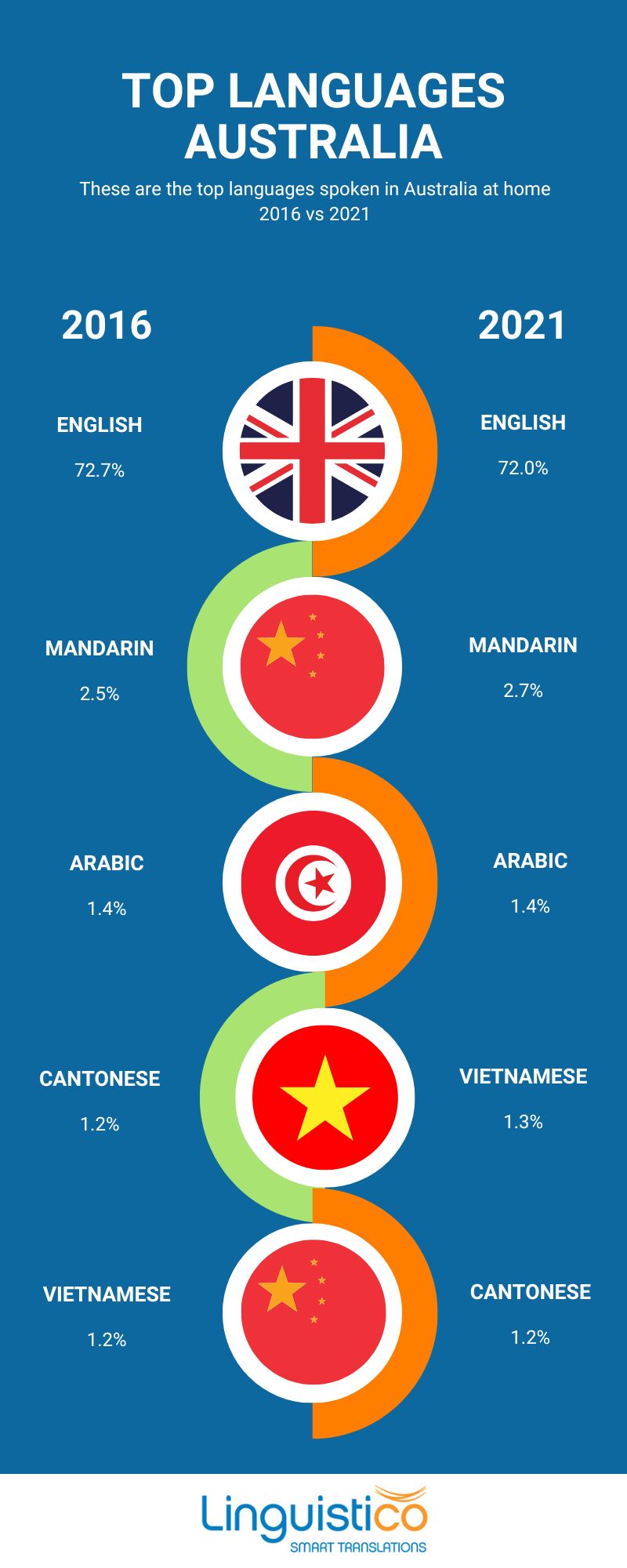Most Common Languages in Australia 2022
21st, October, 2022Our country is one of the most culturally diverse in the world, and the range of top languages spoken in Australia most definitely reflects this. But how can knowing the most common languages in Australia actively benefit your business?
The Australian Bureau of Statistics’ 2021 Census reported over 300 identified languages spoken in Australia, which only goes to emphasise just how important it is for modern institutions to adapt and acknowledge the varying needs of their audience.
In short, whilst English may be the primary language spoken in this country, you can’t necessarily assume that every single member of your community speaks this as a first language. Indeed, the 2021 Census – which at the time recorded 25,422,788 people in Australia – highlighted that 22.3% of Australians spoke a language other than English at home.
So, without further delay, here’s an overview of the most spoken languages in Australia 2022 – and how to address this demand as part of your own business operations.
Top languages Australia
As already mentioned, whilst English is the most widely spoken language in this country, there is an extensive list of the most useful languages in Australia. And by ‘useful’, we mean this in the sense that they are spoken by various communities and can help you to connect with sections of society you may have previously (unwittingly) excluded, or created barriers for, with previous communication.
Excluding English, Australia’s top languages spoken at home(% based on total population) are reported to be:
- Mandarin (2.7%)
- Arabic (1.4%)
- Vietnamese (1.3%)
- Cantonese (1.2%)
- Punjabi (0.9%)
- Greek (0.9%)
- Italian (0.9%)
- Tagalog (0.9%)
- Hindi (0.8%)
- Spanish (0.7%)
We should also acknowledge that today there are more than 100 Australian indigenous languages spoken, including creoles. Sadly, due to the threat aboriginal communities face in the modern world, this is likely to dwindle in the coming years, as a large portion of these indigenous dialects will go extinct through the loss of active speakers.
However, comparing the above data with that of the census’ report on the top 5 languages spoken at home as:
2021
- English only – 72.0% (18,303,661)
- Mandarin – 2.7% (685,268)
- Arabic – 1.4% (367,154)
- Vietnamese – 1.3% (320,760)
- Cantonese – 1.2% (295,292)
2016
- English only – 72.7% (17,020,417)
- Mandarin – 2.5% (596,711)
- Arabic – 1.4% (321,728)
- Cantonese – 1.2% (280,943)
- Vietnamese – 1.2% (277,400)
This again goes to emphasise that outside of English, the most dominant languages spoken within Australian homes are those spoken by our neighbours in Asia (Mandarin, Vietnamese and Cantonese). Indeed, studying these figures shows that between 2016 to 2021 English experienced a decrease from 72.7% (as stated above) to 72.0%, highlighting how more Australian communities are on an upward trajectory of becoming more culturally diverse.

How the most common languages spoken in Australia can benefit you
Whilst most immigrants are required to pass English assessments before being permitted to assume permanent residence in Australia, that doesn’t mean that businesses and other professional institutions cannot still benefit from integrating multiple languages into their official documentation and communication strategies.
Not only does translation help to make occasionally complex and dense subject matters easier to understand for a broader range of individuals, it also helps to foster accessibility and inclusivity as part of your company culture too. Both home and abroad, translation and language diversity can aid interpersonal relationships and ultimately support your operational efficiency too.
Translating important documents with clarity and accuracy is essential for any institution looking to communicate with your multicultural audience, regardless of your industry. At Linguistico, you can be assured that your documents will be translated by professional, qualified human translators – as opposed to machine translations, which can often overlook the cultural nuances or industry knowledge required of specific document translations.
Our own team of Professional and NAATI certified translators are fluent in over 90 languages and as we have over 13 years’ industry experience, we are equipped with a comprehensive understanding of how language trends and demands have evolved in Australia over the past decade.
As we’ve highlighted above, more individuals are speaking a language other than English at home, which has resulted in many pharmaceutical, commercial, legal and government institutions needing their documents translated to a variety of languages to meet this increasing demand.
In this previous blog on translating for your multicultural audience, we highlight how inaccurate translation can be both embarrassing and potentially damaging for the stakeholder and audience. Yet, translation can likewise be an incredibly powerful tool too, securing agreements, increasing trade, developing employee performance and the quality of your overall operations.

In summary, whilst English may be the de facto language in Australia, it is not our official language. By translating your documentation, you will be increasing your efficiency and effectiveness both internally and externally, whilst again increasing your accessibility and inclusivity. As NAATI (National Accreditation Authority for Translators and Interpreters) itself states, you will be able to create a ‘connected community without language barriers’.
Reach out to our team today for more information as to how we can support you. We’d love to hear from you.